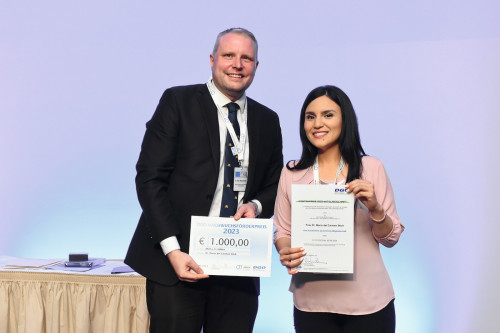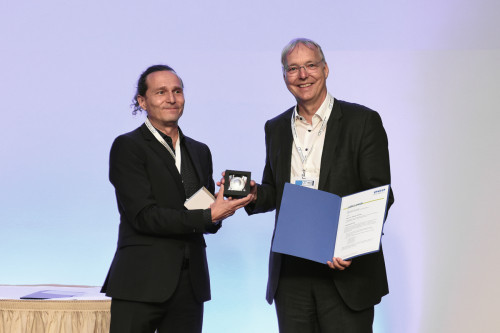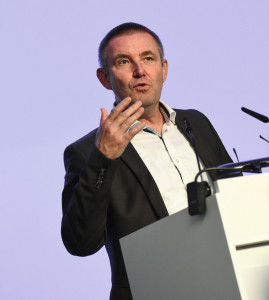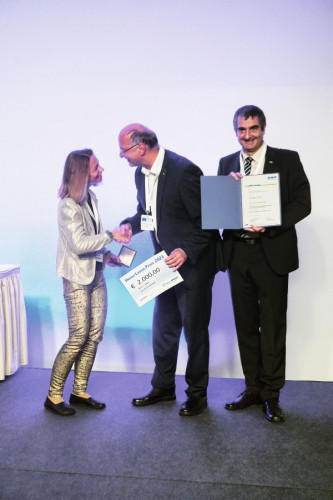Hydrogen, digitalization, energy efficiency and recycling are the trends in the industry, as the ZVO Surface Days from 13 to 15 September showed. What is striking is that these trends correspond well with the transformation of industry and society towards climate neutrality - which speaks for the industry's ability to change. At the Mercure Hotel MOA in Berlin, 540 participants came together for over 90 presentations. Prizes and a strong presentation by former world boxing champion Regina Hallmich characterized the first day of the conference.
BIA CEO Jörg Püttbach welcomed the participants for the first time in his new role as President of the German Surface Technology Association (ZVO) and described the event program as a deliberate mix of tradition and innovation. After welcoming deserving personalities from the industry such as Prof. Wolfgang Paatsch, Dr. Andreas Zielonka and Prof. Andreas Möbius as well as the trainees from the Technical College for Electroplating Technology in Schwäbisch Gmünd and the students from Ilmenau Technical University, he briefly introduced himself to the audience.
Jörg Püttbach learned the profession from the ground up and started his career with vocational training as a surface technician at Blasberg Oberflächentechnik (now MacDermid) in Solingen.
Püttbach then briefly looked back on his predecessor Walter Zeschky's time in office and praised him for his "calm manner, which was good for Board meetings". He then moved swiftly on to the various award ceremonies.
Impressive research work and publications
Dr. Klaus Wojczykowski, the new Head of the Research Committee of the German Society for Electroplating and Surface Technology (DGO), was the first to address the packed auditorium. He introduced the DGO Young Scientist Award winner Maria del Carmen Stich, who received the award for her research into photocatalytic hydrogen production. The award is endowed with 1000 euros and, in addition to the prize money, also includes a free one-year membership of the DGO (also read the interview with del Carmen Stich from p. 1320).
 Dr. Klaus Wojczykowski presented the DGO Young Scientist Award to Maria del Carmen Stich
Dr. Klaus Wojczykowski presented the DGO Young Scientist Award to Maria del Carmen Stich
Prof. Andreas Bund, Head of the Department of Electrochemistry and Electroplating at Ilmenau Technical University, then took to the lectern. He presented the Heinz Leuze Prize, endowed with 2000 euros - currently the most highly endowed prize in electroplating and surface technology after the Nasser Kanani Prize. This year's winner is Prof. Bertram Reinhold from Audi AG in Ingolstadt, who received the prize for his article "Challenges for surface technology: mixed construction in automotive engineering", published in Galvanotechnik 6/2022.
Dr. Zielonka receives most important DGO award
Dr. Martin Metzner, Chairman of the Board of the DGO, then had the task of presenting the Jacobi Prize, the highest DGO award, to Dr. Andreas Zielonka. The former head of the Research Institute for Precious Metals and Metal Chemistry (fem) in Schwäbisch Gmünd received the prize in recognition of his outstanding achievements in research and development in the field of electroplating and surface technology. In his laudatory speech, Metzner emphasized the importance of electroplating processes for the current research focus on fuel cells, battery research and hydrogen technology. In numerous projects, lectures and publications, Zielonka has shown future prospects for electrochemistry and has made a great contribution to its further development, said Dr. Metzner, who in addition to his DGO function is Head of Electroplating Technology at the Fraunhofer IPA in Stuttgart. The Jacobi Prize is named after the German researcher Prof. Moritz Hermann von Jacobi, the founder of electroforming.
 DGO President Dr. Martin Metzner presented the Jacobi Prize to Dr. Andreas Zielonka
DGO President Dr. Martin Metzner presented the Jacobi Prize to Dr. Andreas Zielonka
The awarding of the DGO plaque to the two Nuremberg DGO district group representatives Udo Krüger and Manfred Hoos for their "extreme personal commitment" and Nasser Kanani Prize winner Dr. Mario Kurniawan, who had already received the award, endowed with 3,000 euros in prize money, at the Ulm Dialogue at the end of May, was also highlighted. Just like Maria del Carmen Stich, Kurniawan scored highly with his research into photoelectrochemical water splitting. The publication of his research work will appear for the first time in the next issue of Galvanotechnik.
We are enablers of the energy transition - we are the surface!
Before the eagerly awaited keynote speech by former world boxing champion Regina Hallmich, Jörg Püttbach once again addressed the assembled industry representatives. This was followed by his summary of the general economic situation. He began by outlining the public mood, which is characterized by fears of deindustrialization, high material and energy prices and excessive bureaucratization. According to his analysis, the automotive and construction industries are weakening. This will also lead to empty order books for ZVO companies in the future. His appeal to politicians: "Allow companies to adapt to the change, create infrastructure and focus all your attention on the fight against the climate crisis." At the same time, he pleaded, the chemical bashing must stop, because the industry must be able to compete internationally, but has to contend with poorer framework conditions than elsewhere. In the case of pressing problems such as the chromium (VI) and PFAS issue or the industrial electricity price, the companies are represented by the ZVO, but should also approach politicians and seek dialogue.
Despite all the criticism of the framework conditions, it was important to Püttbach to clearly distance himself from populist demands from the far right. The transformation of society and industry towards climate neutrality offers surface technology many opportunities, such as the possibility of recycling metallic input materials and transferring them into a cycle. He called on the industry to better market its importance and its work in line with the climate targets. "We are the enablers of the energy transition, we are the surface," he concluded.
What boxing and entrepreneurship have in common
Regina Hallmich, now 46 years old and undefeated boxing world champion from 1995 to 2007, inspired the audience with a passionate and honest speech. She started her speech with a parallel between professional sport and surface technology. In both, performance and personal success are crucial.
Hallmich grew up in Karlsruhe and came to boxing via karate and kickboxing. In order to be able to train four times a week for her dream, she had to promise her parents that she would do well at school. Boxing was still a male-dominated sport in the 1990s and it was initially unclear to her how she could achieve her dream of making it to the top.
She celebrated her first successes as European kickboxing champion in 1993/1994. Achieving equality in boxing was a dream that she and her coach pursued together, alongside success in her sport. Today she says: "We brought professional boxing for women to Germany. Her success played a big part in this, but first she suffered her first and last defeat in Las Vegas when she had to fight a bout in which particularly hard gloves filled with horsehair were used. She was knocked out by technical knockout in the fourth round. "With my tenacity, I still managed to become world champion," she looks back today. Her perseverance, her ability to suffer, but also her conviction that every goal is achievable, helped her through the only low point in her career. However, it took much longer for women's boxing to attract more public attention.
Axel Schulz, Dariusz Michalczewski, Wladimir Klitschko and Henry Maske were the male stars of boxing and also the ratings kings on television. Only a women's boxing match at 10 p.m. on ZDF changed that: 9 million viewers watched - a ratings sensation. Suddenly Hallmich was on top, and was even challenged to a fight by TV Total presenter Stefan Raab - who then broke her nose to great media effect. An event that half the nation still remembers today, not entirely without Schadenfreude.
Regina Hallmich learned a lot during these years: "He who doubts loses", "At the top, you go from being the pursuer to the pursued", a piece of wisdom that she immediately associates with surface technology and the market leaders and hidden champions. She has also learned the ability to take criticism and that sometimes you have to be uncomfortable, for example to fight for a better salary.
Hallmich has persistently worked on her dreams with a healthy self-confidence. A strategy that can also be a blueprint for entrepreneurs to overcome their difficulties with new self-confidence.
INFO
Heinz-Leuze Prize: Article on mixed construction in automotive engineering receives award
Prof. Bertram Reinhold from Audi AG is the 2023 Heinz-Leuze Prize winner.
He received the award at the ZVO Surface Technology Days on September 13, 2023. The prize money of 2,000 euros is the highest in the industry after the Nasser Kanani Prize.
Since 1985, the prize has been awarded for a publication in a specialist journal in a German-speaking country with a particularly clear and didactic presentation of an important technical and scientific problem in the field.
The Heinz Leuze Prize is named after Heinz Leuze, son of the publisher's founder Eugen G. Leuze, who headed the specialist publishing house with its current focus on electroplating, surface and printed circuit board technology until 1983.
In his article "Challenges for surface technology: mixed construction in automotive engineering" published in the trade journal Galvanotechnik in summer 2022, Prof. Reinhold addressed the challenges posed by lightweight construction very well and applied them to mixed construction, said Prof. Bund, explaining the decision in favor of Reinhold's specialist publication. "The author also showed very well that mixed construction is a driver of innovation," he added.
The prize, which also includes a solid silver coin, was presented by Britta Kraft, the daughter of publishing director and managing director Sylvia Leuze-Reichert





